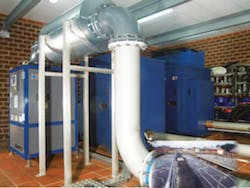Teutonic Turbo
A biological municipal wastewater treatment plant with a considerably fluctuating discharge quantity can only perform its function with utmost energy efficiency and reliability if the process air consumption of the aeration basin can be adjusted continuously and is fully automated in order to deal with widely fluctuating load quantities. This can be achieved with the use of a speed-controlled Aerzen turbo blower.
The sewage treatment plant in Bremervörde, Germany, was designed to have an overall capacity of 30,000 EGW (population equivalents), and with approximately 29,000 EGW, it is now nearly at full capacity. At present, up to 3,000 cu. m of wastewater are fed into the sewage treatment plant every day. However, approximately 1,200 to 1,500 cu. m can be generated by a single production, and the quantity fluctuates particularly due to the rest from work on weekends. The amount of wastewater generated by the resident population in the catchment area in the course of the working week—approximately 1,500 cu. m per day—is nearly constant.
It is obvious that a wastewater treatment system with a wastewater spectrum of 50% to 100% can only be run with optimal energy utilization when the selected process air generators adjust fully automatically to all the requirements. “Therefore, in November 2010, we realized a new concept for the generation of process air,” said plant operator Heiko Müller. “Currently, one new speed-controlled Aerzen turbo blower as active base load plant covers, by itself, our process air requirements across the entire spectrum.
“When so required, we can switch, in addition, two older-model fully automatic positive displacement blowers for generation of the peak load. With this well-tailored distribution of the base load onto an accordingly dimensioned turbo blower and the peak load onto up to two positive displacement blowers, we are now operating our process air station particularly energy efficient. The subject ‘energy costs’ is for us extraordinarily important, because for the process air generation we have to spend about 75% of the total energy costs of our wastewater treatment plant.”
Larger control range
In the past, positive displacement blowers made by Aerzener Maschinenfabrik generated the process air for the aeration basin. These units were replaced in 1999-2000 by two Aerzen Delta Blowers. One unit covered the requirement, while the second served as redundancy. Both units were already speed-controlled, so they could be adjusted to the fluctuating requirement in a range of between approximately 35 and 50 Hz. However, in their lower performance range, the blowers could not cover even the lower load requirement anymore.
Therefore, supplementary units had to be found. These had to be speed-controlled on one hand and have a wide performance spectrum on the other. Additionally, if possible, they should be able to run 100% in speed-controlled load-run operation across the entire requirements spectrum.
New Aerzen turbo blowers
In November 2010, a new Aerzen turbo blower type AT 100–0.6 (driving power 75 kW) was installed. Since it was commissioned, the unit has run 10,700 operating hours (as of February 2012) and has run almost entirely without no-load operation periods around the clock in volume-controlled load operation, which proves its optimal design. This unit, which has a capacity spectrum of 36 to 80 cu. m per min., now serves as the base load generator for process air supply for the wastewater treatment plant in Bremervörde.
The two Aerzen positive displacement blowers from the old supply concept can be connected automatically as standby units and as peak load generators. Since about 75% of the electrical energy used in the Bremervörde wastewater treatment plant is used for generating process air, the new concept offering particularly economical handling of electrical energy was an absolute precondition.
Before making the decision to purchase the Aerzen unit, plant operators had determined that due to the available depth of the basin, a discharge pressure of 0.4 bar would be sufficient for optimal aeration. Onto this value, the impeller of the blower was customized for the highest possible energy efficiency. Higher pressures—up to a maximum of 1.0 bar—can be serviced using corresponding impellers.
All three units—the new Aerzen AT turbo blower and the two approximately 12-year-old Aerzen positive displacement blowers—were installed in a separate building. The supply air enters from the outside. A filter mat prevents dust from penetrating into the unit. Warm exhaust air supported by a fan escapes the room. All the units supply via a bus bar in the station directly into the aeration basin. A probe in the basin continuously measures the oxygen content and controls the delivery volume of the process air via the speed of the units. At the end of the treatment process, the treated water is discharged into the adjacent Oste River with a purity degree of approximately 95%.
“With this concept, we meet our requirements optimally and with highest possible energy efficiency,” said Müller. “The turbo blower works with its broad performance spectrum as ideal base load unit in spite of our widely fluctuating input quantities, between 1,500 and 3,000 cu. m per day. Depending on the requirements, the Aerzen positive displacement blowers can be connected fully automatically as peak load units.
“With our new concept for generation of process air, as per our experience, we found an optimal solution with highest possible energy efficiency. Our expenditure on maintenance amounts to just a few minutes a year for changing the filter mats. And the specialists from Aerzen guarantee an optimally adapted overall concept. We are convinced that with the present combination—with one turbo blower for the base load and two positive displacement blowers for peak load and standby—we realized an ideal and very commendable concept. With this, we can supply our biologically working wastewater treatment plant and make it safe to operate, reliable and especially energy efficient with process air.”
